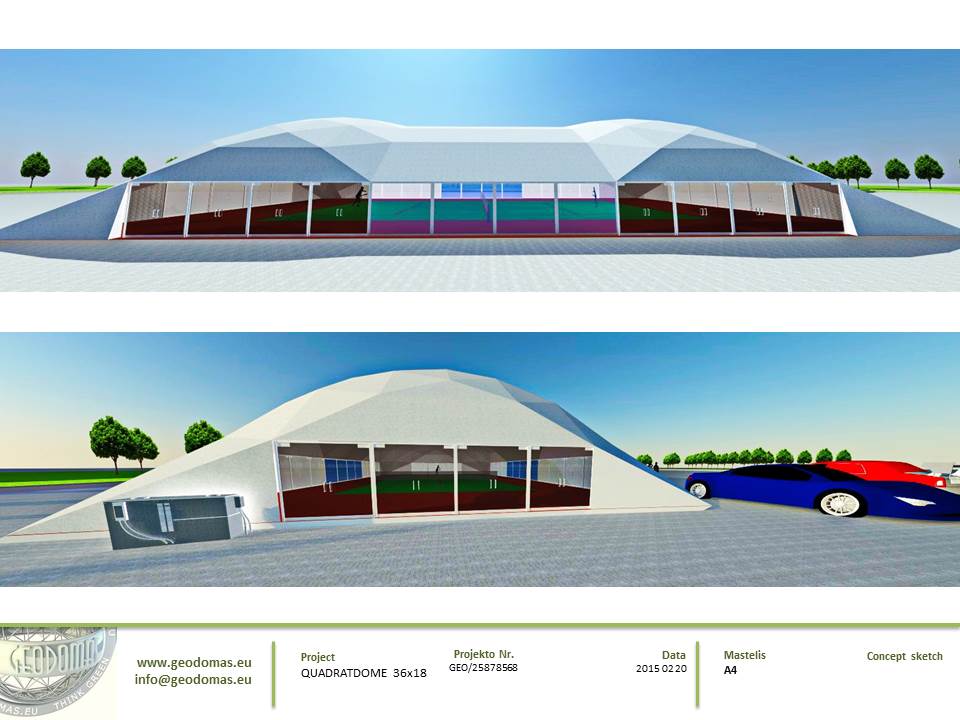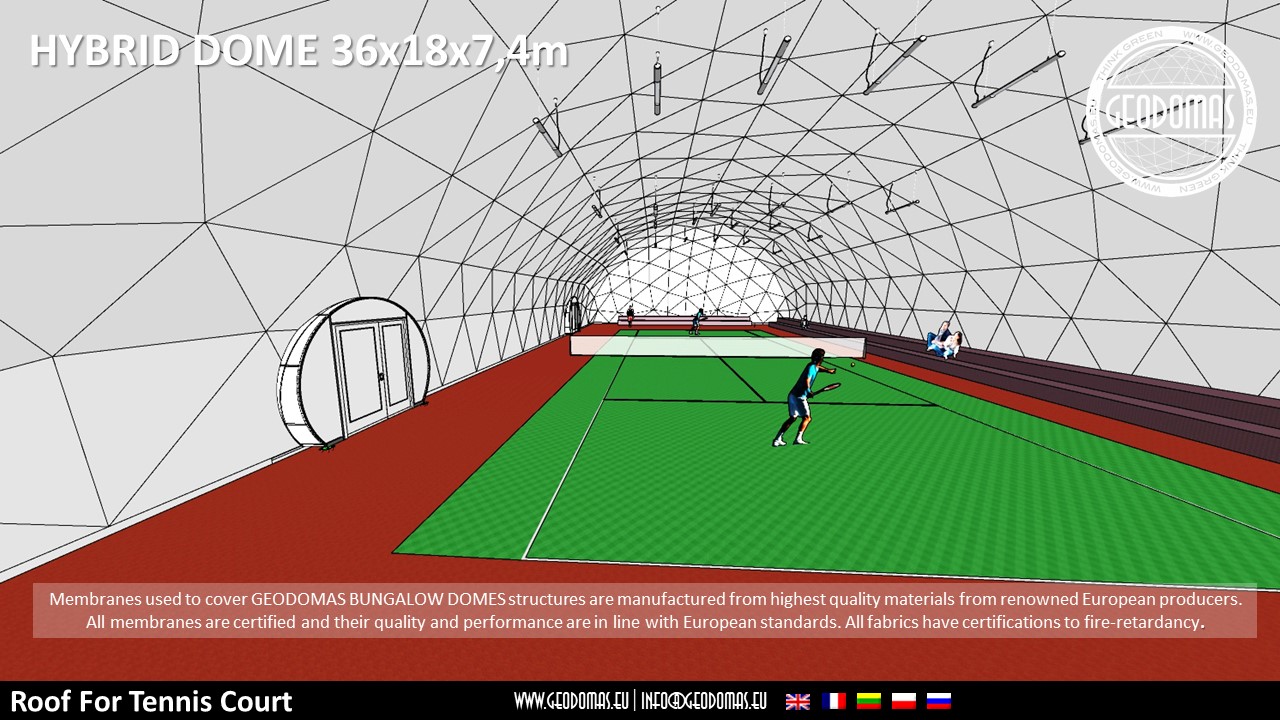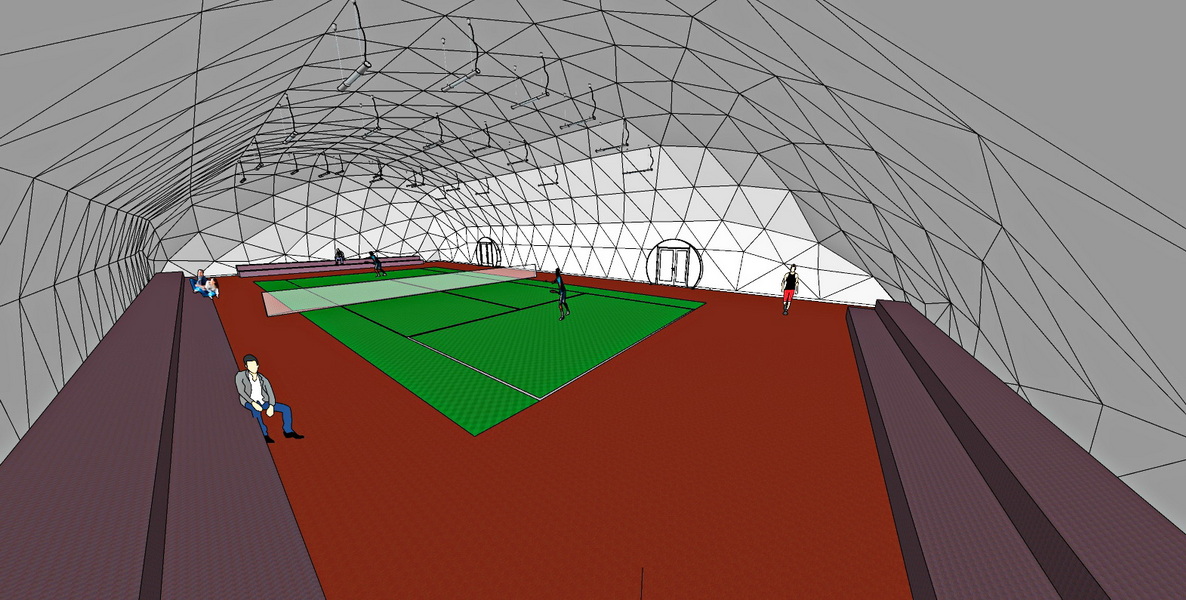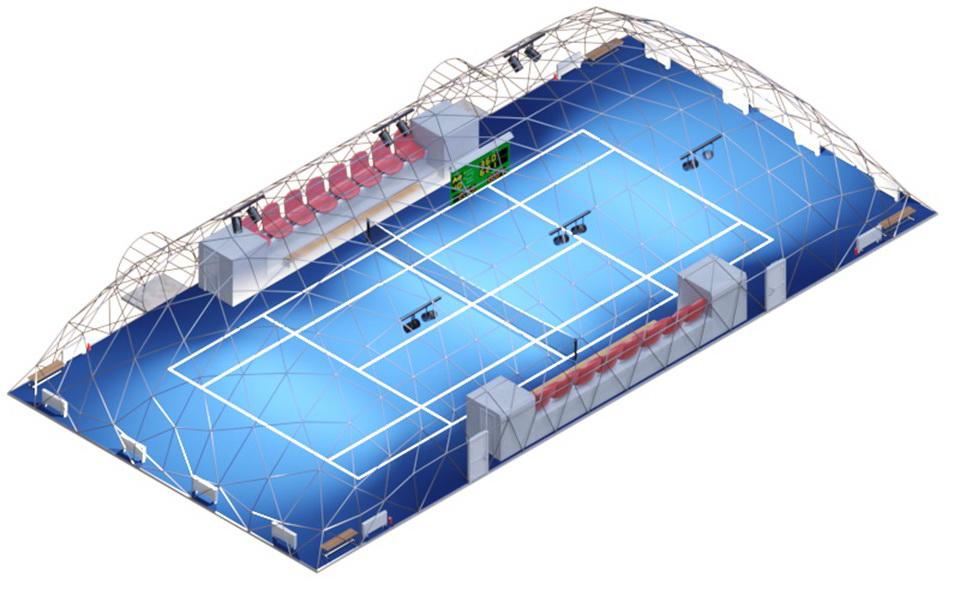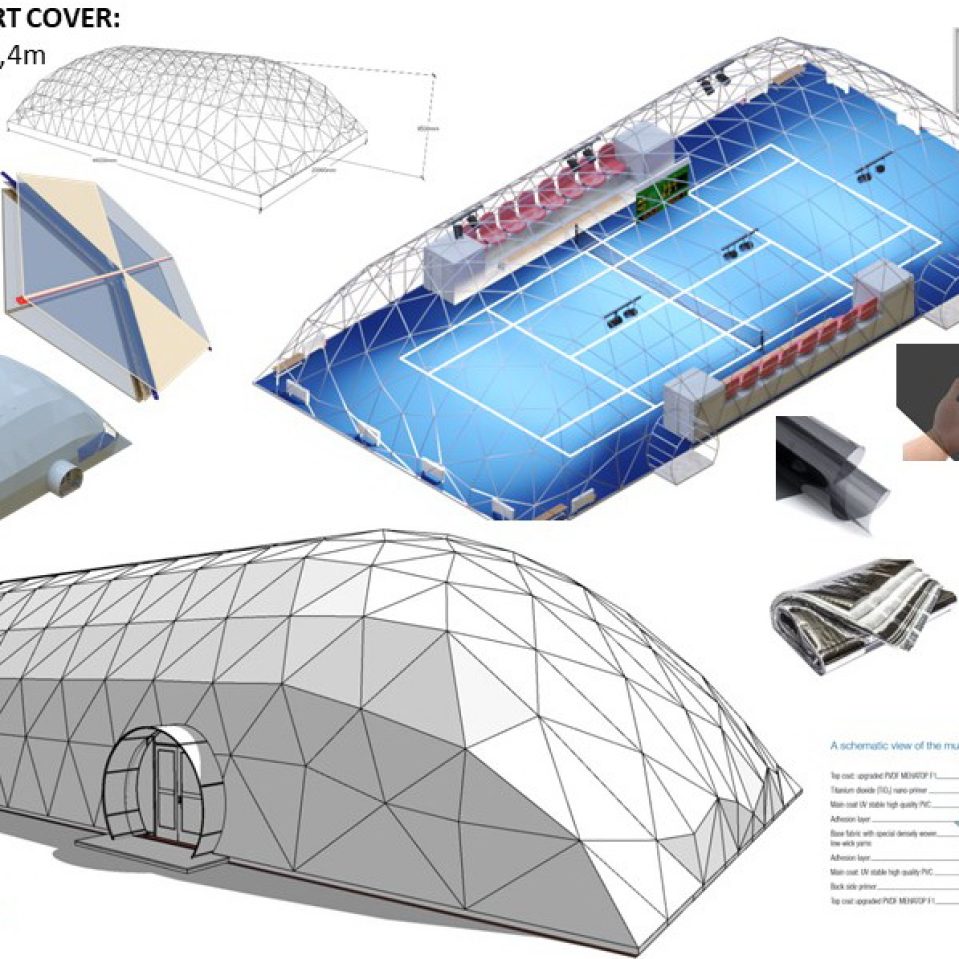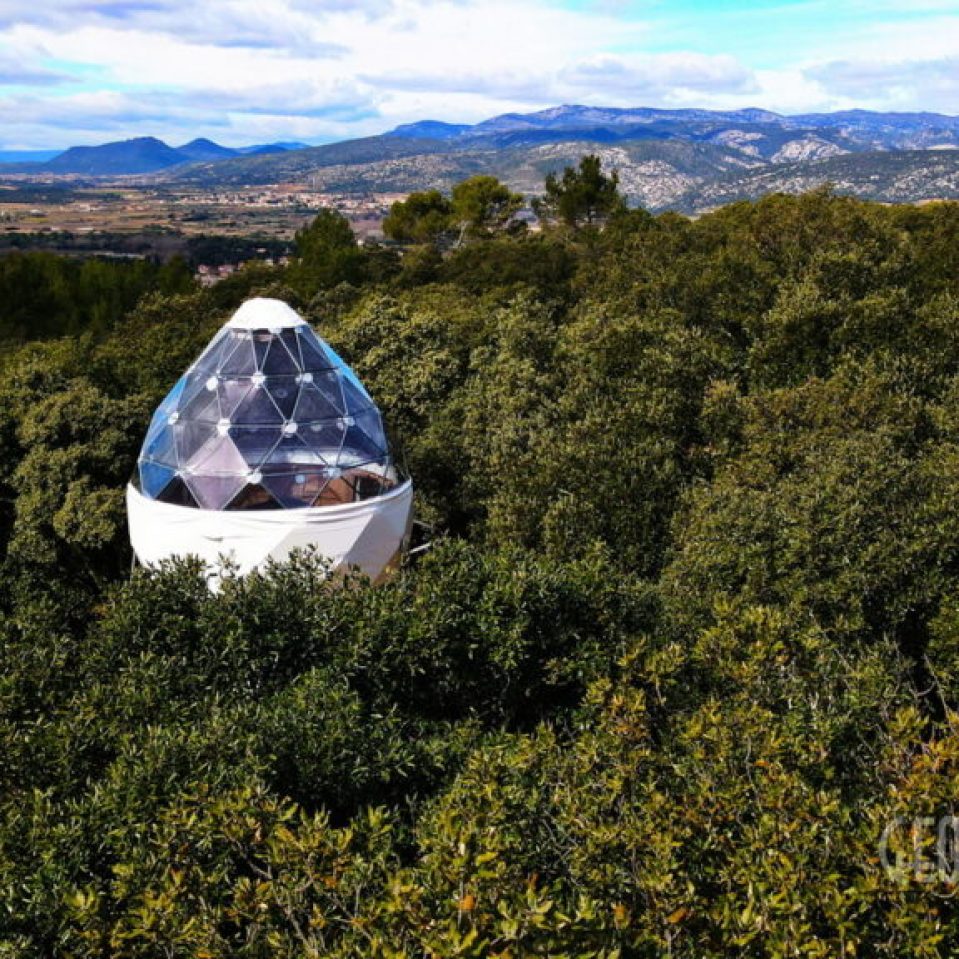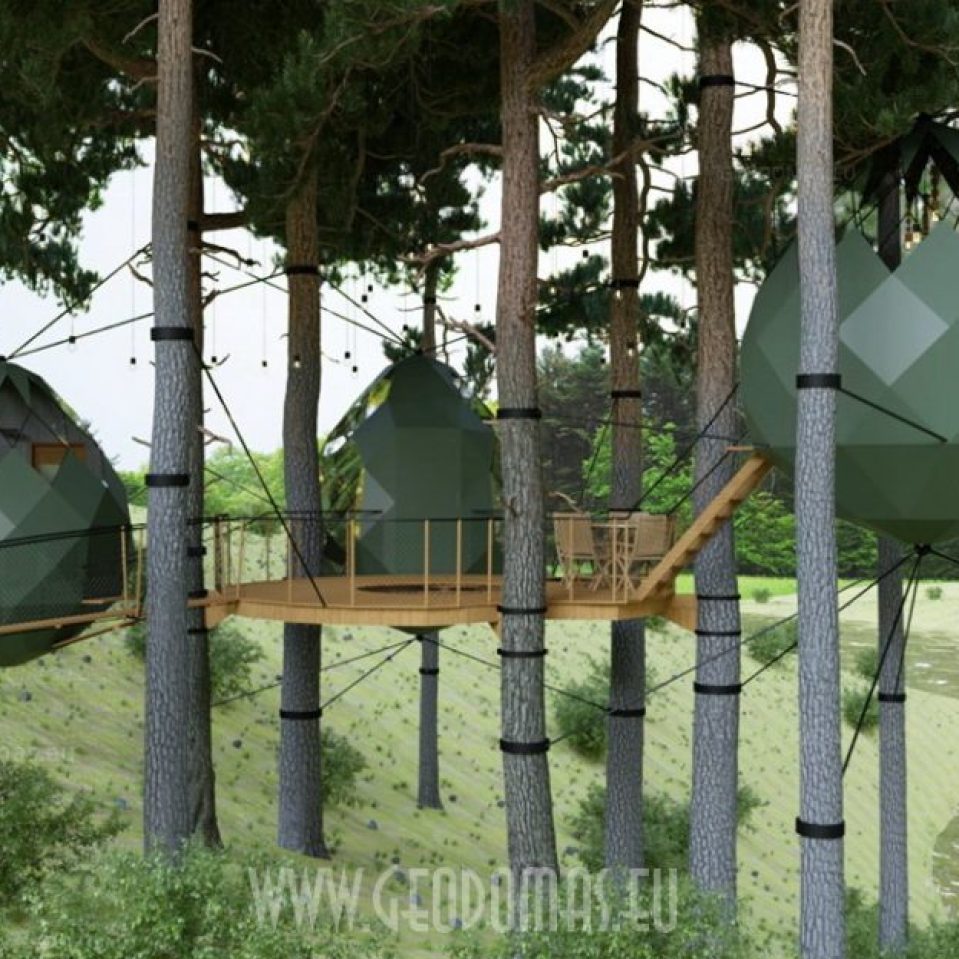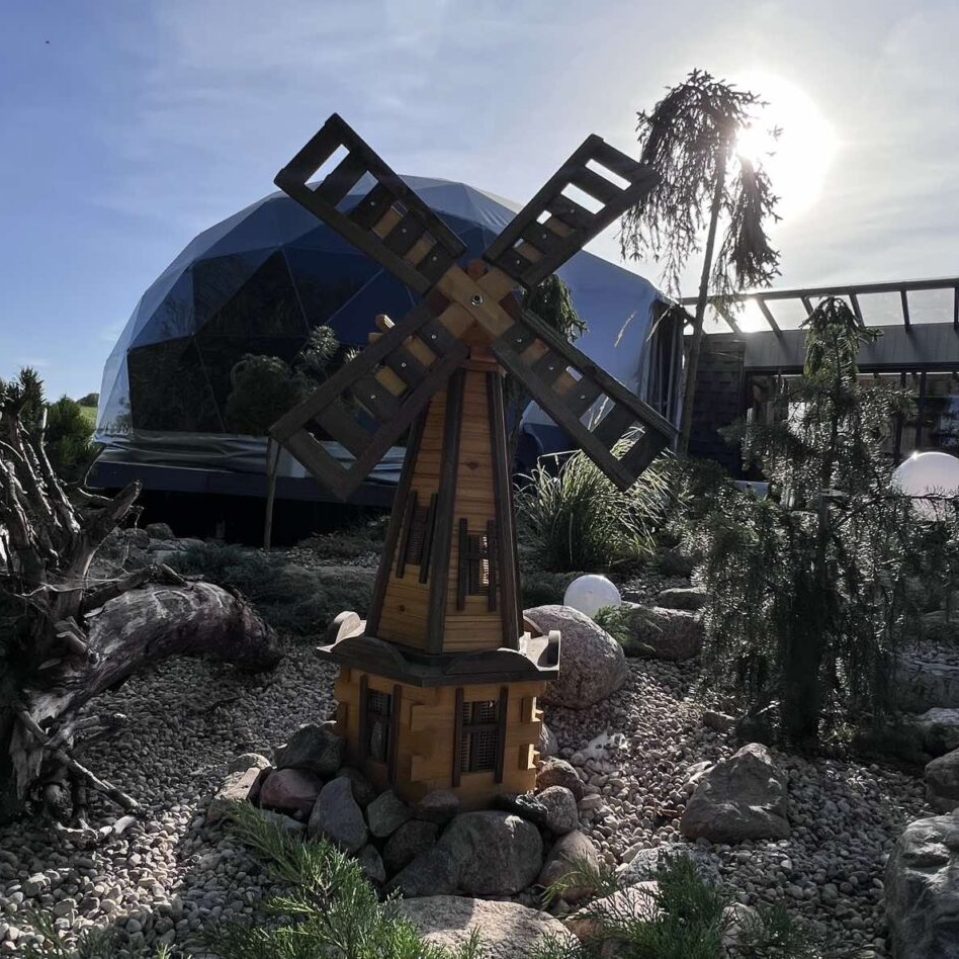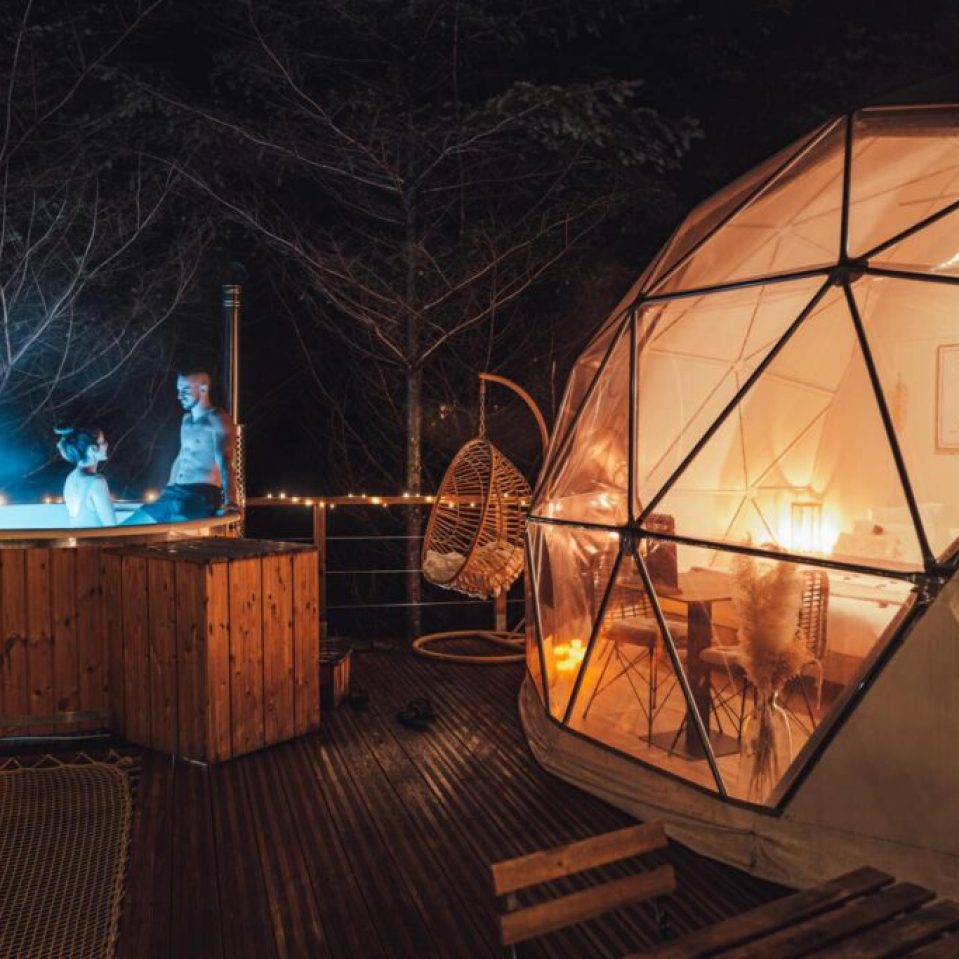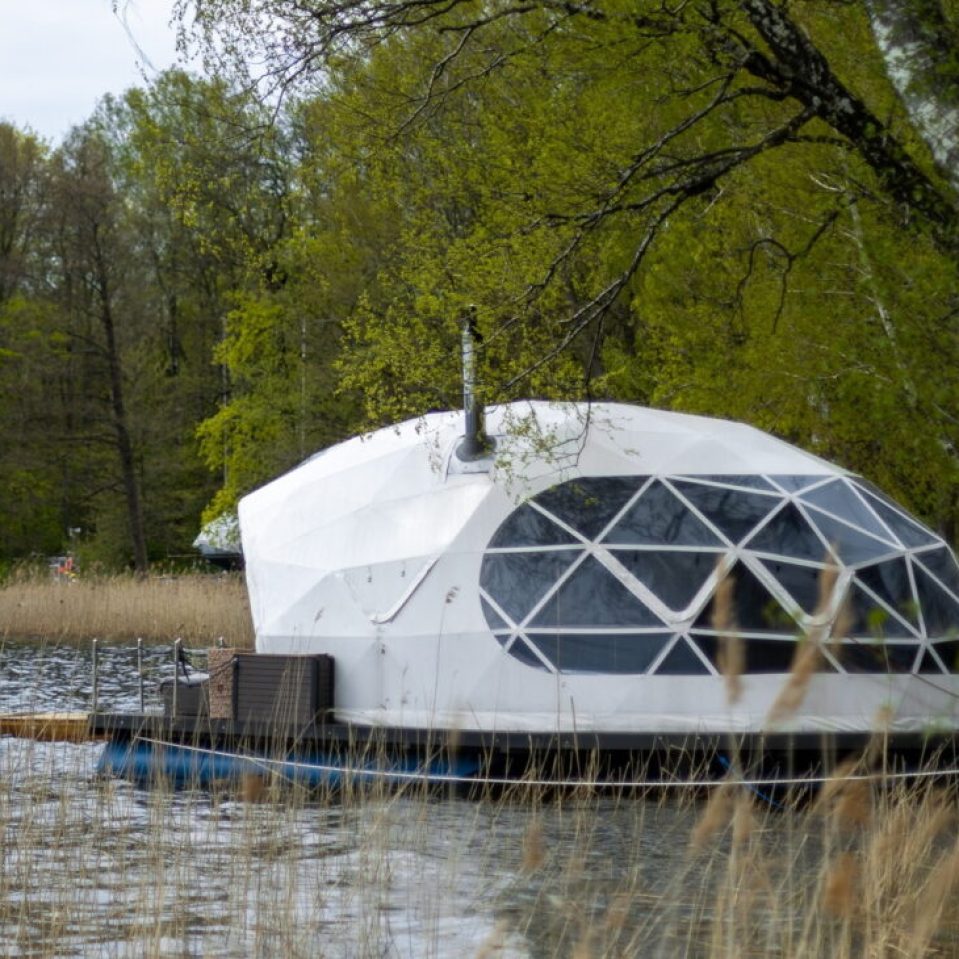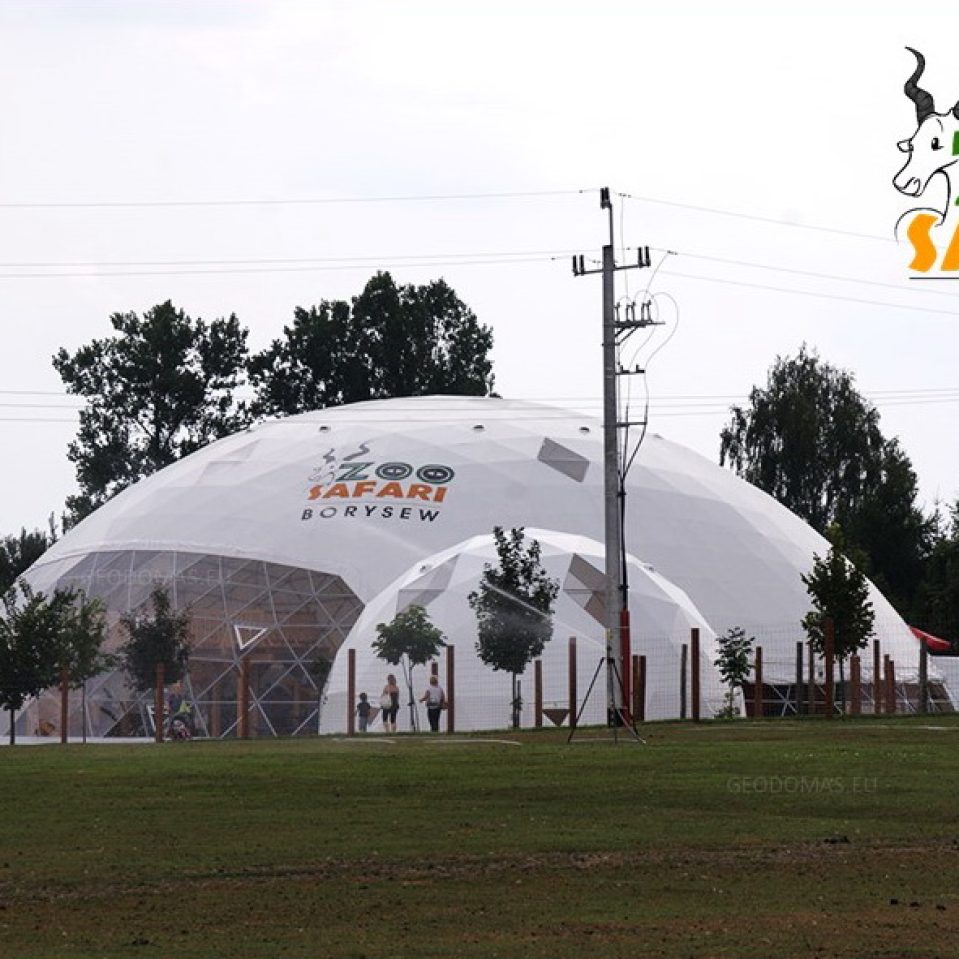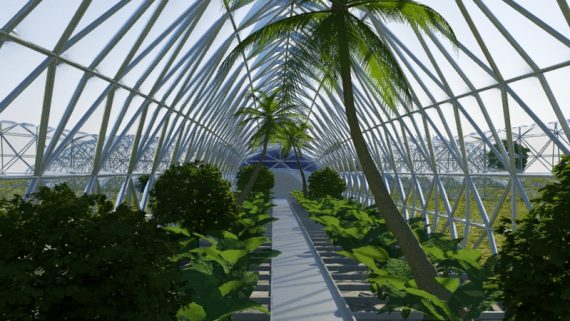

648m2 Tennis Court Dome Roof 36x18x7.4m | Glamping for Sport
Dome technologies offer an excellent opportunity to create robust and durable structures that are ideally suited for covering various types of sports courts. One such example is the Qvadrat Dome roofs designed specifically for tennis courts. These domes are constructed from metal rod frameworks, assembled without the need for welding, which allows for quick and efficient assembly and disassembly without the need for additional support structures.
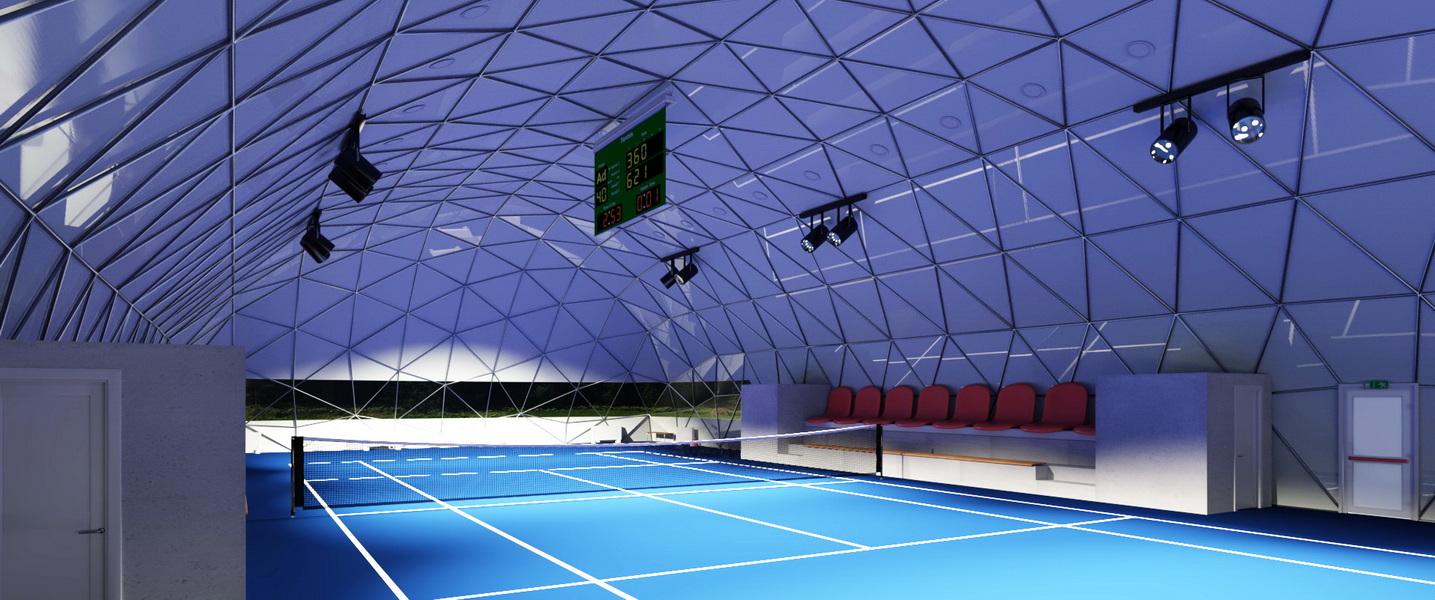
The dome covering is made from high-quality reinforced PVC textile, providing reliable protection against extreme weather conditions. The interior layer of the dome is lined with a thermal insulation membrane, which helps maintain an optimal temperature inside, even during the coldest weather. Additionally, the sound-dampening finish ensures that athletes can focus on their game without being disturbed by external noise.
It’s important to note that these structures do not have internal support columns, so the loads are evenly distributed along the perimeter. This design provides more space and flexibility for court layout and installation. These domes can be used not only for tennis courts but also for other sports facilities such as basketball courts, volleyball courts, arenas, swimming pools, and more.

Qvadrat Dome roofs for sports courts not only expand the usability of these facilities throughout the year but also add an aesthetic and architectural uniqueness, harmonizing with the environment and creating a cozy and positive energy.


Please note that when designing private tennis courts, the out-of-bounds areas can be customized to meet your specific needs. Contact us, and we will offer the most suitable solution based on your preferences and the size of the court.
Regarding the tennis court lighting system, it is essential to consider several key requirements:
-
Horizontal Lighting: This lighting ensures sufficient illumination at ground level, allowing players to clearly see the court surface and the ball’s position.
-
Vertical Lighting: This is particularly important to ensure the ball is clearly visible in the air when it is between 4.5 to 8 meters high. This helps players better orient themselves and follow the game’s progress.
-
Lamp Protection: Lamps must be protected from impacts and moisture to ensure long-term and reliable operation. This is crucial to prevent damage to the lamps that could occur during impact or under adverse weather conditions.
-
Color Temperature: The lighting system should create a natural daylight feel, so players feel as if they are outdoors rather than in an enclosed space. This helps reduce eye strain and provides comfort during play.
-
Lamp Longevity: The longer the lifespan of the lamp, the more cost-effective the lighting will be in the long term. This reduces the need for frequent replacements and ensures consistent lighting.
Ensure that your tennis court lighting meets all these requirements to create optimal conditions for players, regardless of the time of day or weather conditions.
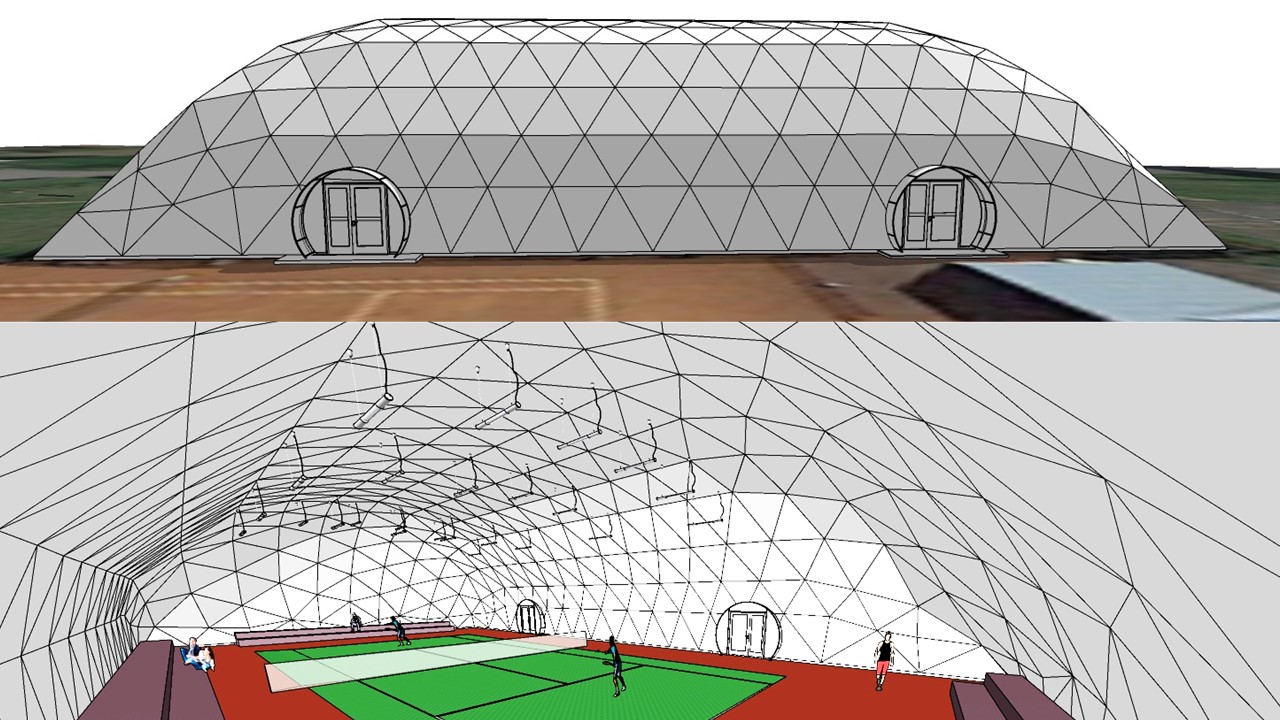
Research has shown that the sphere is a lightweight and economical structure for several reasons:
-
Optimal Shape for Resilience: The spherical shape is ideal for enhancing a building’s resistance to wind, rain, and snow. Due to its simple yet reliable construction, modern architecture increasingly recommends spherical homes in seismologically hazardous areas.
-
Maximized Volume with Minimal Surface Area: The sphere has the greatest volume relative to its surface area. This means that to achieve the same usable space, fewer materials are required for wall construction compared to other shapes. This is evident when comparing the perimeters of circles and rectangles with the same surface area.
-
Material Efficiency: Following from the previous point, the surface area of a sphere is approximately a quarter less than that of a cube with the same volume. As a result, spherical buildings require roughly 25% fewer materials than cubic ones.
-
Efficient Ventilation: Spherical structures lack corners where air tends to stagnate, making them easier to ventilate. Additionally, ventilation issues can be easily addressed with airtight doors at the top of the sphere.
-
Explosion Resistance: Spheres are difficult to blow up. Even if an explosion occurs in a localized area, the structure tends to maintain its integrity and does not collapse due to the even distribution of loads across the surface.
-
Innovative Design Possibilities: Spherical compositions offer new visual forms for various applications such as swimming pools, greenhouses, parking lots, shops, and more.
These advantages make spherical structures not only aesthetically unique but also structurally and economically superior for a wide range of architectural projects.

ONLINE SHOP
POPULAR PROJECTS
ASTRONARIUM ANIANE site, the site of one of the largest amateur astronomical observatories in Europe with unusual accommodation to sleep under the stars.
Our proposal for the site, which faces forest beyond, includes 3 Tree-Hotels standing amongst the trees for a high-end holiday resort.
Welcome to Beskid Glamp, a unique resort nestled in the picturesque Jaworze Mountains of Poland. This luxurious glamping destination offers an unparalleled experience, combining the serenity of nature with the comforts of modern amenities. Beskid Glamp is the perfect escape for those seeking a blend of adventure, relaxation, and wellness.
In the very South of Lithuania there is a village of Česukai (Varėna district). This place distinguishes in fantastic natural surroundings, marvelous views of Merkys river and an authentic building which is called the Pyramid of Merkinė.
Here is the Mas du Versadou, one of the most beautiful 18th century mas in the Camargue. It is located in a protected area, surrounded by rice fields and meadows for horses and bulls.
Building is classified to a simple structures category, so the expertise is optional.Complex harmoniously integrated between pond and thickset pinewood.Hard task to keep proportion between comfort, luxurity and construction mobility realized successfully. Classic style interior decorated with curtains, furniture and thick soft carpet.
At Star Valley, we offer an unforgettable experience—a stay in our unique geodesic domes, each reflecting one of the four elements. This is the perfect place for those who appreciate a peaceful setting and want to escape the hustle and bustle of the city. Our dome accommodations allow you to enjoy the serenity of nature in comfort and style.
Nestled beside a tranquil lake, deep within the heart of an ancient forest, lies a sanctuary where time seems to pause, and the world transforms into a serene reflection of stillness and peace. This private retreat, surrounded by the whispers of rustling leaves and the gentle lapping of crystalline waters, is home to two sacred domes—spaces where the wisdom of the universe and the secrets of ancient rituals reside.
Are you looking for a unique nature retreat that combines comfort, uniqueness, and a special connection with the natural world? Feeling exhausted from the city’s fast pace and stress, and seeking to slow down time and experience absolute tranquility? The floating boat is not just a means of transportation; it’s like a floating home, full of luxury and comfort. Your footsteps echo on the wooden floors, each step reminding you of stability and security. This boat’s design ensures maximum comfort and resilience against any natural conditions.
Pilviškės is a village in the north-east of Vilnius district, near the Lithuanian-Belarusian state border. The city stage will open up new creative opportunities for the residents of their town.
The “VIP Dome” project in Liutonys, Lithuania, is a distinctive and exclusive space designed for events, conferences, and other special occasions. The dome itself covers an area of 254 square meters, complemented by a VIP loft space of 100 square meters. Nestled in the picturesque Degučiai Valley, this modern structure is built using cutting-edge technology, offering a sense of luxury and elegance.
Inside your living dome you can delight in the free feeling of open, spacious design. Completely free-standing, there are no internal supports to obstruct your view, but the option is there if you wish to add interior walls or additional levels. Your vision will come alive as your dome is crafted exclusively for your location offering the perfect view, natural light, and desired privacy.
Set in Borsk in the Pomerania region, Podniebny Glamping offers accommodation with free private parking, as well as access to a sauna. Each unit is fitted with air conditioning, private bathroom and a kitchenette including a fridge and a stovetop. There is a seating and a dining area in all units.
Introduction of this season, a 8 meter diameter dome of 50 m2 – GLAMPING DOME. One can watch the sunsets through the dome window during any weather. The dome is adapted for air temperatures of -30 to +80 degree Celsius and has a THERMIC.PRO13+ thermal membrane.
Today, on the 15th of May, at the Central rescue station of Palanga, sea rescuers begin their watch. They will be on duty 24 hours per day until the middle of August – 15th day. Summertime weather is attracting more and more holidaymakers to the sea, however most of them enjoy only sun baths and only a few of them decide to swim in the sea.
Sun Garden Glamping Domes is located in Călimăneşti, 46 km from Vidraru Dam and 5.7 km from Cozia Aqua Park, offering accommodations with free Wi-Fi, air conditioning, and access to a garden with an outdoor pool. Private parking is available on-site. This luxury tent features a terrace and a children’s playground. The nearest airport is Sibiu International Airport, 85 km from Sun Garden Glamping Domes. Families particularly appreciate this location, rating it 9.5 for a stay with kids
Glamp Royal Resort is a unique and luxurious glamping project located in the picturesque Tatra Mountains near Zakopane, Poland. This resort offers an unforgettable experience with four themed domes, each covering an area of 35 m². The domes provide breathtaking panoramic views of the mountains, allowing guests to fully immerse themselves in the beauty and tranquility of nature.
Welcome to Moon Glamping, a unique resort nestled deep in the tranquil forests, where nature and luxury converge into one harmonious experience. This is the perfect destination for those seeking peace, relaxation, and an authentic nature experience.
Domaine Ouréa was born from a strong interest in nature, ecology, contemporary architecture and travel. We have done our best to combine all of these criteria and create a unique project that reflects us. The goal is that you enjoy it as much as we are passionate about this adventure.The Kittilä eco-lodge will immerse you in a Lappish atmosphere. This geodesic dome with panoramic views is located 4 m high in the middle of the trees on a terrace built from local Vosges wood.
The floating boat is not just a means of transportation; it’s like a floating home, full of luxury and comfort. Your footsteps echo on the wooden floors, each step reminding you of stability and security. This boat’s design ensures maximum comfort and resilience against any natural conditions.
Dome 28 meters in diameter, placed in Bologna (Italy) to promote new models of Nissan Juke. At the Bologna Motor Show 2012 Nissan has brought its range of sport cars and surprised even the unique Juke-R. Exhibited for the first time in Dubai in January 2012 this car has been a great success so the Ray Mallock Ltd. under the supervision of Nissan Technical Centre Europe decided to continue the development of the car. The engine is the 3.8 V6 twin-turbo from GT-R r35 with 545 hp capable of pushing the little juke to 275 km/h and sprint from 0 to100 km/h in about 3 seconds
GLAMPING FOR BUSINESS
One of the biggest dome project made by Geodomas. Geodesic shelters have been built around the world in various climates and have proven to be the strongest and most efficient human shelter ever conceived.
You should see our conept art down below. A good design begins with a good design concept. We trying to solve a task and your concept will lead the way and give you direction for your design decisions.
Dome can be transformed into the conference-hall or planning a gala celebration, business presentation, board meeting, banquet. It is perfect for seminars and conferences, since it can place up to 15 members.
Building is classified to a simple structures category, so the expertise is optional.Complex harmoniously integrated between pond and thickset pinewood.Hard task to keep proportion between comfort, luxurity and construction mobility realized successfully. Classic style interior decorated with curtains, furniture and thick soft carpet.
The “VIP Dome” project in Liutonys, Lithuania, is a distinctive and exclusive space designed for events, conferences, and other special occasions. The dome itself covers an area of 254 square meters, complemented by a VIP loft space of 100 square meters. Nestled in the picturesque Degučiai Valley, this modern structure is built using cutting-edge technology, offering a sense of luxury and elegance.
ALAUŠO SLĖNIS is the Leisure and Events Centre situated on a picturesque west shore of Lake Alaušas (~110 km away from Vilnius, ~135 km away from Kaunas). The Centre started its activities in August, 2008; it occupies a spacious area exceeding 4 ha, we can accommodate 68 guests.
Step into a world of immersive entertainment with our 65m² Portable 4D Cinema Dome, specially designed for a full Glamping experience in Varna, Bulgaria. This state-of-the-art dome structure, measuring 7×11 meters, offers a unique blend of cutting-edge technology and unparalleled comfort, allowing guests to experience movies like never before.
Our team invites you to dive into the adventure, where we will experience what is a real refuge of nature with rain, sun, mud and water. We will meet with secrets outside and treasures inside.
The biggest in Europe and Asia Complex, which was designed for the youngest visitors. The largest tent, an area of about 1,000 square meters is playfully with the Bar Lunch and a mezzanine, with the amount of which has panoramic views of the zoo. Connected with this place are two more tents. One is a professionally equipped sakla education, in other toilets.
Today, on the 15th of May, at the Central rescue station of Palanga, sea rescuers begin their watch. They will be on duty 24 hours per day until the middle of August – 15th day. Summertime weather is attracting more and more holidaymakers to the sea, however most of them enjoy only sun baths and only a few of them decide to swim in the sea.
Imagine going to bed every night and waking up to the perfect, harmonic resonance that is part of a GEODOMAS dome experience.






